Family : Solanaceae

Text © Prof. Giorgio Venturini

English translation by Mario Beltramini
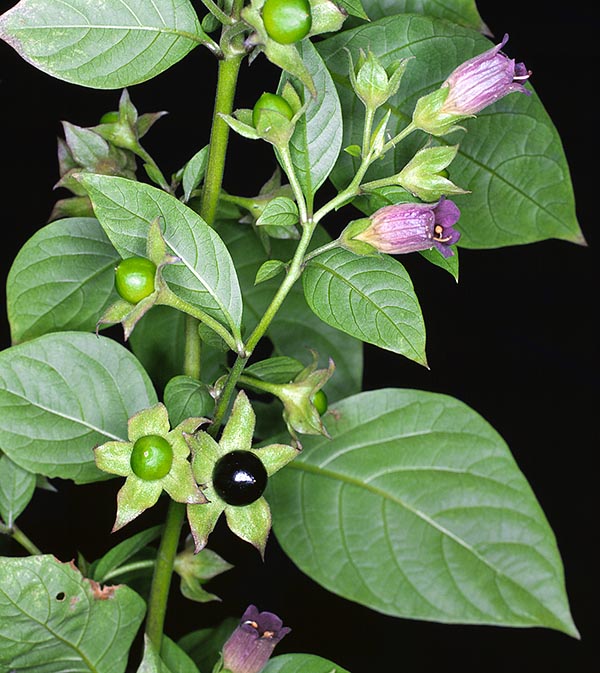
All parts of Atropa belladonna, roots in particular, are highly toxic © Giuseppe Mazza
It grows in the mountain and sub-mountain zones, humid clearings in the broad leaved woods, especially of beeches and more rarely of oaks, up to 1500 m of altitude. Amply distributed in all Central and Southern Europe, North Africa and South-western Asia, has been introduced in North America and is cultivated as officinal.
The name of the genus Atropa comes from Atropos, one of the three Fates of the Greek mythology, personification of the inevitable destiny. The Fates were Clotho (κλωθω in Greek means to spin), the one who was spinning the thread of everybody’s life, Lachesis (λαχησισ in Greek means fate), the one who was measuring the length of the thread, that is, of the life assigned by the destiny and Atropos (ατροποσ = inflexible) who, with his scissors, did cut it, decreeing the death.
To the three Fates have been dedicated three poisonous species: Clotho is rightly a spider (nowadays Uroctea), Lachesis muta is a great venomous pit viper of the Amazon forest (the terror of the woods, surucucu in Brazil, shushupe in Peru).
The name of the species belladonna comes from the practice, known since the old times, of utilizing a watery extract of the plant as eye drops for dilating the pupil of the ladies and getting them a seducing look. After another hypothesis, it should come from the French term “belle femme”, used in the Middle Ages for indicating the witches who used this plant to prepare hallucinogenic ointments. The plant emanates an unpleasant smell. The leaves are opaque, large (5-9 cm x 10-15 cm), oval, with entre or slightly lobed margin, acuminate at the apex, alternate and hairy. The leaves carried by the stem are single, opposite. On the branches, the leaves are in pairs, one bigger and the other smaller, both alternate. The flowers, which bloom from June to September, are carried by a 1-2 cm peduncle; the calyx has a 5-6 mm tube and 4-5 mm teeth.
The corolla is brown violet, yellowish inside with dark venations. 5 stamina androecium with big anthers, bilocular ovary with only one style and bifid stigma. Black berry when ripe, glossy, spherical of about 15-20 mm. The plant is pollinated by insects.
Toxicity and pharmacological properties
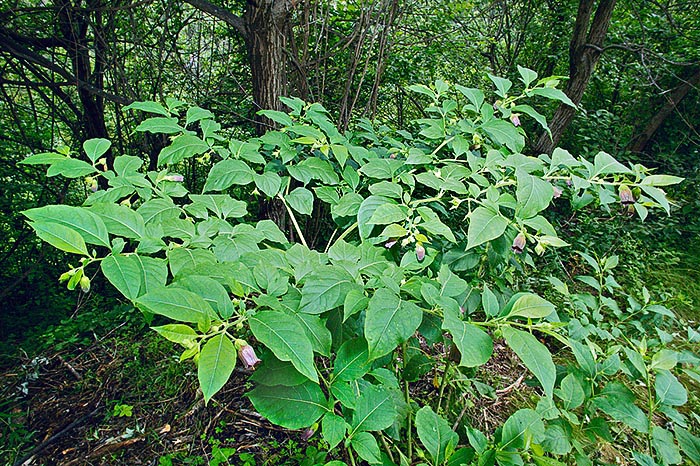
Even 2 m tall, grows in mountain and submountain zones, wet glades and the woods edges up to 1500 m of altitude © Giuseppe Mazza
All parts are highly venomous, in particular the roots. The fruits are the least toxic part of the plant but are also responsible of many poisonings due to their showy look which attracts especially the children. The toxicity and the pharmacological properties are analogous to those of other Solanaceae, such as the Jinson weed (Datura stramonium) and Henbane (Hyoscyamus niger) but the deadly nightshade is particularly dangerous due to its content extremely high of active substances. The toxicity is mainly due to the alkaloids Atropine (DL-Hyoscyamine), L-Hyoscyamine and Scopolamine or Hyoscine. These substances inhibit competitively the link of neurotransmitter acetylcholine to its muscarinic receptors of the central nervous system and of the autonomic parasympathetic nervous system (see text of the Hyoscyamus niger). The effects caused by the deadly nightshade are: alterations of the cognitive capacities with amnesia and block of the learning, hallucinations, inhibition of the salivary, gastric and intestinal secretions, vasoconstriction, mydriasis (dilation of the pupil), tachycardia, nausea, vomit and, at high dosage, hallucinations, coma and death. Atropa belladonna is toxic even for many tame animals, to which it causes narcosis and paralysis. On the contrary, the rabbits eat the leaves without any apparent damage.
Also many birds nourish of the fruits and contribute to the diffusion of the plant by dispersing the seeds through their excrements. Many insects are immune to the toxicity of the deadly nightshade: for instance, Epitrix atropae chrysomelid coleopteran is typical parasite of the deadly nightshade and also the larvae of the Potato bug (Leptinotarsa decemlineata), another chrysomelid, famous and very dangerous parasite of the potato, can grow nourishing of its leaves.
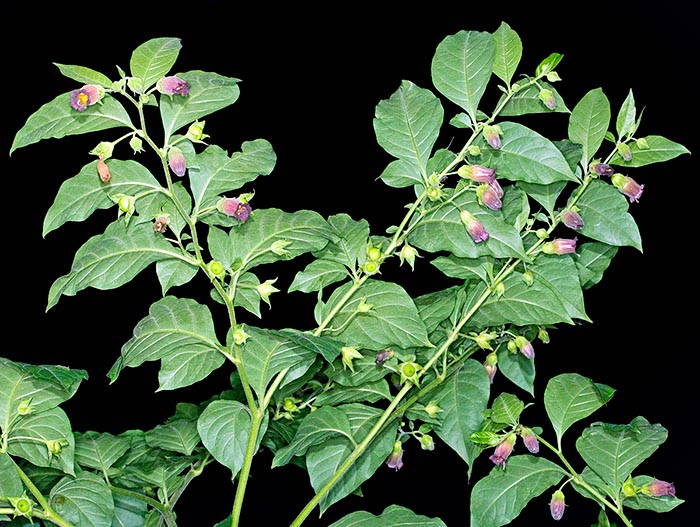
Choice material since old times for doctors, poisoners and witches, has ramified viscous stem © Giuseppe Mazza
The main application is the ophthalmological one, to induce dilation of the pupil (mydriasis) in the exams of the fundus.
It is administered also before the induction of the anaesthesia. The atropine is also utilized in the treatment of the poisonings caused by organophosphoric esters (for instance, pesticides) and in the poisonings by mushrooms. It has also an application, associated with other medicines, as sedative. Preparation based on deadly nightshade are utilized in homeopathy, even if there is no scientific evidence of their efficacy, seen that the dilution of the most used preparation in homeopathy is 30C, corresponding to a dilution of 1060 (to get a comparison, we must think to a drop of deadly nightshade diluted in an enormously bigger volume than that of all the oceans; which means that in the solution there are no molecules of the deadly nightshade, but water only).
Atropa belladonna, like also the other pharmacologically similar plants, such as the Datura (Datura stramonium) and the Henbane (Hyoscyamus niger), is occasionally used for voluptuary purposes as narcotic, thanks to the lively hallucinations and to the delirium it may cause. In reality, the hallucinations caused by these plants are often very unpleasant and the use is extremely toxic due to the high risk of potentially fatal overdosages. It should be noted that the content of toxic substances of the plant, in any case very high, is extremely variable in unpredictable way.
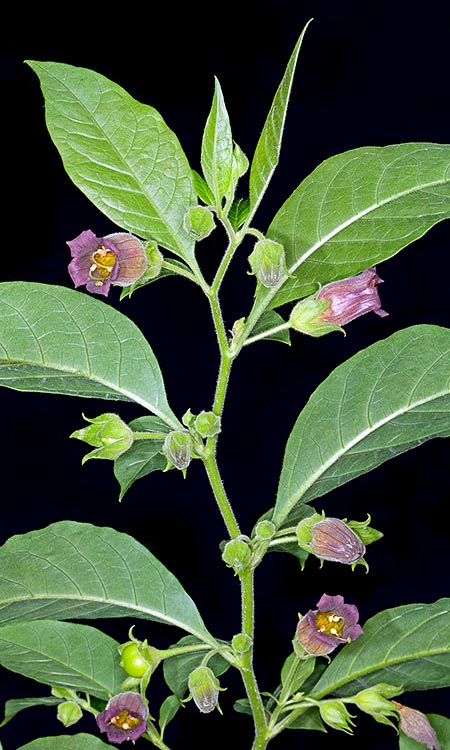
Medicinal, anaesthetic, hallucinogenic, often deadly plant © Giuseppe Mazza
“Did anyone ever try to drink a decoction of leaves of dead nightshade? I did, after having even eaten two leaves, and I have had a “trip” (that is, a voyage in hallucination status) which lasted 72 hours!” And so on, describing other similar stunts. We must not be astonished if even very serious incidents do happen.
When reading these things, it seems to see again the known history of Barry Kidston, a young American researcher who, while trying to synthesize in laboratory an opioid drug (MPPP) to use for its own consumption, obtained instead a molecule unknown by that time, now known as MPTP, which he injected himself intravenously, getting the terrible result of causing himself the Parkinson’s disease (he had, by chance, synthesized a substance damaging selectively the same neurons which are affected by the Parkinson and which now is used for the studies on this disease). Saved from immediate death, but now with the nervous system damaged, Kidston will then die for heroin overdose. I cite this famous case of absurd behaviour as an example of the dangerousness of the use of narcotic substances in general and of those produced by one in particular.
History, magic uses and poisonings
The deadly nightshade has a quite long history as medicine, cosmetic and poison. Since ancient times it has been used as anaesthetic for surgeries. In the old Greece, the Maenads, followers of Dionysus, assumed the deadly nightshade for inducing the trance. The plant was called “circaeon” with reference to the witch Circe, enchantress and poisoner. The Roman priests of Bellona, the goddess of war, drank an infusion of deadly nightshade before invoking the goddess. The army of Marcus Antonius, during the wars against the Parthians suffered from a mass poisoning by deadly nightshade. It seems that the soldiers, short of food, had eaten plants collected in the woods.
The death of the Emperor Claudius has been attributed to the administration of deadly nightshade done by an infamous poisoner, called Locusta, who was later on imprisoned and sentenced to death (AD 68) for this crime. The executioner was punished, but not the instigator, almost surely Agrippina, Claudius’ wife and mother of Nero who succeeded as emperor rightly replacing Claudius. Also for the death of the first emperor, Augustus, they suspect an intervention with the deadly nightshade done by the wife Livia, anxious to see the son Tiberius on the throne. It is clear that inside the Julia gens, for the succession to the throne, they did not rely on the natural death but they were looking for a pharmacological help.
Galenus (129-201), the most famous physician of old Rome, did cite in his treatises the therapeutic effects of the deadly nightshade. They say that this has saved Scotland from the invasion of the Danes during the XI century. The Danes would have asked for some mead as part of the loot for granting a ceasefire. Macbeth, by the time general of Duncan, King of Scotland, gave mead doped with deadly nightshade. Then killed the during their sleep (Macbeth, later on, killed King Duncan and ascended the throne, also making himself a bad end later on). In Shakespeare, Macbeth and after meeting the witches wonder if the meeting has been a hallucination caused by some root, probably meaning the deadly nightshade.
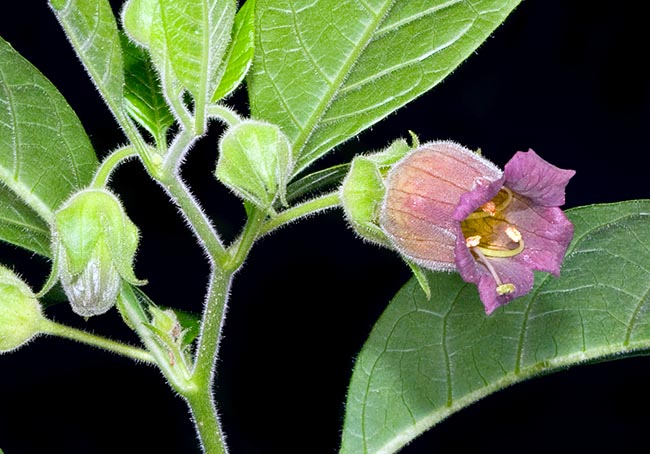
Unpleasant smell, as befits a "Devil plant" and violaceous flowers © Giuseppe Mazza
Shakespeare, Macbeth, Act 1.
Thessaly, in old Greece, was famous as land of witches, who, after the tradition, administered a wine with deadly nightshade as powerful love potion, which, assumed in the right dosage increased the sexual desire but in excess caused a breathing paralysis. It was also used by the ladies as eyewash for being more desirable.
The deadly nightshade in the Middle Ages was considered as a plant of the devil probably because of its toxicity but also for its diffused utilization done by witches, sorcerers and shamans. Due to its hallucinogenic power, the plant was used for inducing the status of trance, for the divination and was one of the components of the witches ointments used for the “flight” (please see the text of the Henbane). The application of the ointment was accompanied by magical formulas like this one, reported in the acts of a trial to a witch in Umbria in the ‘400 “Unguento unguento, mandami alla noce di Benevento supra acqua e supra vento et supre ad omne maltempo”, that is, “Ointment, ointment, send me to the nut of Benevento, over water and over wind at over any bad weather”.
Seen that the Deadly nightshade was considered as property of the devil, he who was collecting it risked to meet face to face with the devil who is wandering to care and collect his plants. They said that only once a year, the night between April 30th and May 1st, the devil was ignoring his cares, as he was getting ready for the Sabbath of the night of Valpurga.
The accidental poisonings due to ingestion of deadly nightshade are numerous, probably due to the inviting look of the berries and, mainly due to the ignorance. Very often in fact the deadly nightshade is collected, or even grown, in lieu of edible grasses. Here is an example reported by a newspaper of June 2013:
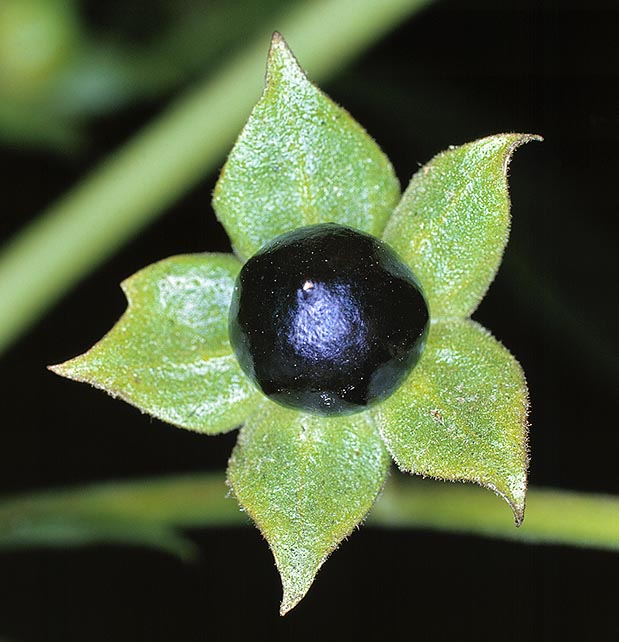
Glossy black berries at the centre of a stellar structure unluckily attract the children © Giuseppe Mazza
In 2013 the Italian press reports three more similar cases, but by sure these are not exceptional events. The medical literature in fact relates of 62 hospitalized cases in England between the 2007 and the 2011 due to ingestion of parts of the plant. To these cases we have to add the numerous intoxications due to the use of the plant or of its extracts as hallucinogenic narcotic.
After the poison control centres, in USA, in 2007 have occurred 938 cases of intoxication by deadly nightshade or similar plants. The data of the other years are equivalent.
Among the reported cases, the oddest one is probably that of a priest who, while camping, had eaten the berries of the deadly nightshade and has been found wandering naked in the wood, hallucinated, and refusing any help. After a study carried on over 29 years, the Atropa belladonna has caused more serious incidents than any other plant.
The most common poisoning symptoms appear rapidly and are: mouth dryness, nausea and sometimes vomit, mydriasis (dilated pupils), unsteady gait (the poisoned people look drunk), vertigoes, breathing difficulties, involuntary emission of faeces and of urine. In the most serious cases, delirium with hallucinations, followed by coma, and possibly, by death by general paralysis in 24-36 hours.
As already mentioned, the deadly nightshade has been often used by poisoners. Besides the already quoted cases of the old times, two are the famous cases of the modern ones. The Swiss nurse Marie Jeanneret poisoned with the deadly nightshade seven patients, by mid ‘800, but was largely superseded by an American nurse-poisoner, Jane Toppan, who, in 1901 confessed to being the author of 31 murders, and who utilized the deadly nightshade for part of her crimes.
Synonyms: Belladonna baccifera Lam. ; Belladonna trichotoma Scop.
→ To appreciate the biodiversity within the SOLANACEAE family please click here.
